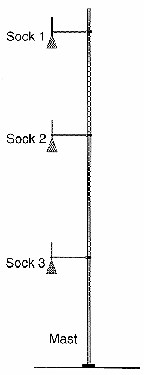Where do you go to test components that will one day land on Mars? How about just outside the Phoenix Sky Harbor International Airport? That is one place you can sometimes find Dr. Robert Sullivan, a postdoctoral research assistant at Arizona State University (ASU). For the past year, Sullivan has been designing instruments that will provide information about wind speed and direction on Mars after Mars Pathfinder lands in July 1997 (see sketch below).
To determine wind speed and surface characteristics that allow scientists to understand how windblown sediments are transported on Mars, they need to measure the wind profile at different heights above the surface. The two Vikings that landed on Mars in 1976 only measured wind speed at 1 height.
Greeley knew just the person for the job. Rob Sullivan did a study in 1987-88 that measured wind profiles over rough and smooth surfaces on a dry lake bed in California. He then compared the results to a miniaturized version of the lake bed set up in a wind tunnel at ASU. Sullivan also did a Ph.D. investigating the geomorphology of Mars.

Sketch of Mars Pathfinder wind socks on 1-meter high mast. Diagram by K. Edgett, based on dimensions provided by R. Sullivan.
The Physical Sciences Machine Shop at ASU crafted the wind socks from aluminum and stainless steel according to Sullivan's exact blueprints. Sullivan speaks very highly of Bob Taylor and his machine shop crew. "They have been fantastic. They do great work," he said. NASA and the Jet Propulsion laboratory agree that the quality of workmanship is high-- the ASU Physical Sciences Machine Shop was recently certified to produce parts that can be sent into space (see MGS TES article), and they will do the work on the actual wind socks that are going to Mars.
The wind socks are tested in Professor Greeley's wind tunnel at ASU. The wind tunnel tests provide calibration that allow Sullivan to further test the wind socks outside in natural settings. He has been to two places-- the Mars-like desert of Death Valley, California, and the obviously non-martian airport in Phoenix. The airport provides a nice, open area near ASU that Sullivan can get to easily. The results of tests done to date have been excellent. Additional testing has been done in wind tunnels at NASA Ames Research Center and in the Mars Garden at UA.
Mars Pathfinder and its microrover are slated to land in Ares Valles on July 4, 1997.
A young teen at the time, Sullivan remembers quite fondly the day that Viking 1 touched down on Mars in 1976. He said the first pictures sent back by Viking were "fascinating." He says that working on the IMP Wind Sock experiment has been a great opportunity to be part of a "fundamentally creative" scientific engineering project. Sullivan and Greeley, along with Peter Smith and the rest of the IMP team, have about 28 months of work ahead. It all pays off on July 4, 1997, when Mars Pathfinder. becomes the first U.S. spacecraft to land on Mars in 21 years.
Permission from the Author required to reproduce this text
Arizona Mars K-12 Education Program / edgett@elvis.mars.asu.edu